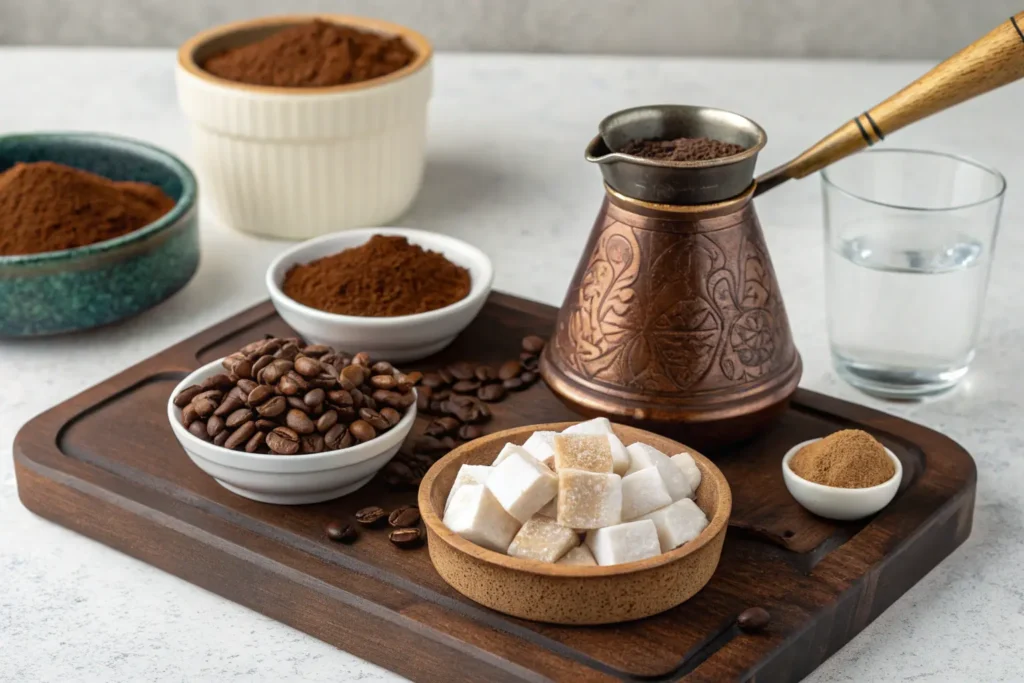Physical Address
304 North Cardinal St.
Dorchester Center, MA 02124
Physical Address
304 North Cardinal St.
Dorchester Center, MA 02124

Picture this: the rich, intoxicating aroma of finely ground coffee beans dancing with cardamom fills your kitchen. Steam rises from a small copper pot as you slowly stir, watching the liquid transform into something magical. This isn’t just coffee—it’s a 500-year-old tradition that connects you to generations of coffee lovers who understood that brewing Turkish coffee is as much about the journey as the destination.
If you’ve ever sipped authentic Turkish coffee in a bustling Istanbul café and wondered how to recreate that same soul-warming experience at home, you’re about to discover the secrets that have been passed down through centuries. Today, we’ll transform your kitchen into a Turkish coffee sanctuary where every cup tells a story of tradition, patience, and artistry.

Turkish coffee holds a special place in world culture—so special that UNESCO recognized it as an Intangible Cultural Heritage in 2013. This recognition wasn’t just about the beverage itself, but about the entire cultural ecosystem surrounding its preparation and consumption. When you brew Turkish coffee at home, you’re participating in rituals that have shaped social interactions, marriage customs, and daily life across the Ottoman Empire for over five centuries.
The traditional preparation method remains virtually unchanged since the 16th century, when coffee houses first appeared in Constantinople. This consistency speaks to the perfection of the technique—when something works flawlessly for 500 years, there’s little need for improvement.
Your typical morning coffee routine involves hot water passing through grounds, leaving the coffee particles behind. Turkish coffee takes a completely different approach. The ultra-fine grind—we’re talking powder-like consistency that’s 2-3 times finer than espresso—stays with the liquid throughout the entire brewing process and even in your cup.
This unfiltered brewing method creates several unique characteristics:
The brewing temperature never reaches boiling point, which preserves delicate flavor compounds that would otherwise be destroyed by excessive heat.
The cezve (pronounced “jez-VEH”) or ibrik is the heart of Turkish coffee preparation. This small, long-handled pot isn’t just a vessel—it’s an engineering marvel designed specifically for this brewing method. The wide bottom provides optimal heat distribution, while the narrow top concentrates the foam formation.
Material considerations for your cezve:
For home brewing, choose a cezve that holds 2-4 servings. Smaller sizes give you better control over the brewing process, which is crucial for achieving that perfect foam.
Your Turkish coffee setup requires minimal equipment, but each piece plays a crucial role:
| Equipment | Traditional Choice | Modern Alternative | Price Range |
|---|---|---|---|
| Cezve | Copper | Stainless Steel | $15-$80 |
| Grinder | Manual Burr | Electric Burr | $25-$200 |
| Cups | Porcelain Fincan | Small Espresso Cups | $10-$40 |
| Spoon | Small Teaspoon | Demitasse Spoon | $5-$15 |
The grinder deserves special attention. Turkish coffee demands an extremely fine grind that most home grinders simply cannot achieve. If you’re serious about authentic Turkish coffee, invest in a quality burr grinder or purchase pre-ground coffee from a specialty Turkish market.

Arabica beans work best for Turkish coffee, offering the complex flavor profile and lower acidity that complement the brewing method. While some traditionalists prefer specific Middle Eastern blends, high-quality Arabica beans from Central and South America produce excellent results.
Roast level recommendations:
The grind size makes or breaks your Turkish coffee. You need consistency finer than powdered sugar—around 45-50 microns if you want to get technical. This ultra-fine grind allows maximum extraction during the brief brewing time and creates the signature texture.
Grinding tips for home preparation:
Success in Turkish coffee brewing starts with precise measurements. Unlike other coffee methods where you can adjust strength by varying brewing time, Turkish coffee requires exact ratios from the beginning.
| Ingredient | Amount (per cup) | Quality Notes |
|---|---|---|
| Finely ground Turkish coffee | 1 heaping teaspoon (6-8g) | Ultra-fine powder consistency |
| Cold water | 3 fl oz (90ml) | Filtered water preferred |
| Sugar (optional) | 1-2 teaspoons | Add according to preference |
| Cardamom (optional) | 1-2 pods | Enhances traditional flavor |
Turkish coffee culture recognizes four sweetness levels, each with its own name:

Begin by measuring your water using the actual coffee cup you’ll drink from. This ensures perfect proportions every time. Pour the cold water into your cezve, then add sugar if desired. Stir until the sugar completely dissolves—this step is crucial because sugar won’t dissolve properly once you add the coffee.
Add the finely ground coffee to the sweetened water and stir thoroughly. The mixture should be completely smooth with no lumps. This initial mixing determines your coffee’s final texture, so take your time to achieve uniformity.
Place your cezve on the lowest heat setting available. This cannot be emphasized enough—Turkish coffee demands patience and gentle heat. High temperatures will ruin the delicate balance you’re trying to achieve.
Critical brewing steps:
The serving process is as important as the brewing. Pour slowly and steadily, allowing the foam to distribute naturally. Each cup should have a golden-brown foam layer on top—this foam is your badge of brewing success.
Traditional accompaniments include:
Overheating problems: The most common mistake is using too high heat. This causes the coffee to boil, destroying the foam and creating bitter flavors. Always use the lowest heat setting and be patient.
Insufficient heat solutions: If your coffee never foams, gradually increase heat while maintaining constant observation. Some electric stoves require slightly higher settings, but the key is gradual, controlled heating.
Incorrect grind size: Coarse grinds won’t extract properly and create a weak, watery coffee. Too fine, and you’ll get muddy, over-extracted bitterness. The grind should feel like flour between your fingers.
Proper ratios: Measuring by eye leads to inconsistent results. Use a scale for accuracy—6-8 grams of coffee per 90ml of water produces the traditional strength.
No foam formation: Usually caused by excessive heat or insufficient stirring. Start over with lower heat and more gentle stirring.
Bitter taste: Over-extraction from boiling or stale coffee. Use fresh grounds and maintain proper temperature control.
Weak coffee: Insufficient coffee or grind too coarse. Increase coffee quantity or find a finer grind.
Turkish coffee offers unique health benefits due to its unfiltered preparation method. The fine grounds release maximum antioxidants, making each cup a concentrated source of beneficial compounds.
Nutritional highlights:
Consumption recommendations: Limit intake to 1-2 cups daily, especially if you’re sensitive to caffeine. The concentrated nature makes Turkish coffee more potent than regular drip coffee.
Brewing authentic Turkish coffee at home transforms your daily coffee ritual into a meditative practice that connects you to centuries of tradition. Every perfectly foamed cup you create tells a story of patience, skill, and respect for cultural heritage.
The journey to mastering Turkish coffee requires dedication and practice, but the rewards extend far beyond the beverage itself. You’re preserving an ancient art form while creating moments of mindful preparation that slow down your busy day.
Remember that perfection comes through repetition. Each brewing session teaches you something new about heat control, timing, and the subtle signs that indicate your coffee is ready. Don’t be discouraged by initial attempts—even experienced Turkish coffee makers sometimes struggle with foam formation or temperature control.
Ready to start your Turkish coffee journey? Begin with quality equipment, fresh coffee, and most importantly, patience. Your first cup might not rival those served in Istanbul’s historic coffee houses, but with practice, you’ll develop the skills to create authentic Turkish coffee that honors this remarkable tradition.
Share your Turkish coffee experiences with friends and family. This ancient beverage was always meant to bring people together, creating connections over shared appreciation for craftsmanship and culture. Start brewing today, and discover why this 500-year-old method continues to captivate coffee lovers worldwide.

What makes Turkish coffee different from regular coffee? Turkish coffee uses an ultra-fine grind and unfiltered brewing method where the coffee grounds remain in the cup. This creates a unique texture and intense flavor that’s impossible to achieve with filtered brewing methods.
How fine should I grind coffee beans for Turkish coffee? The grind should be extremely fine—like powdered sugar or flour. This consistency, around 45-50 microns, allows proper extraction during the brief brewing time and creates the signature texture.
Can I make Turkish coffee without a cezve? While a cezve produces the best results, you can use a small, heavy-bottomed saucepan as an alternative. However, the authentic experience and optimal foam formation come from using a proper cezve.
Why doesn’t my Turkish coffee have foam? Foam formation depends on proper heat control and technique. Common causes include excessive heat, insufficient stirring, or stale coffee grounds. Use low heat and be patient—foam develops gradually over 5-7 minutes.